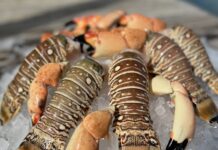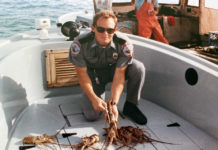
Reports of widespread coral disease in Lower Keys reefs, and summer heat coming, could spell trouble for remaining healthy coral systems, say local researchers tracking the event.
“As of several weeks ago, researchers have documented diseased coral on Looe Key Reef,” said Keys Marine Lab’s Cindy Lewis. “We have been monitoring identifiable colonies, and one particular colony without disease at all, that now have disease.”
Back in late 2014, coral disease incidents were reported near Key Biscayne by staff of the state Department of Environmental Protection and area scientists. In a year’s time, nearly 55 linear miles of reef experienced widespread disease, according to the environmental agency. By 2016-17 the disease continued to spread as far north as Palm Beach County and south to Lower Matecumbe.
“While the coral disease outbreak is unprecedented, so is the collaborative response to it,” said Sarah Fangman, superintendent of the Florida Keys National Marine Sanctuary. “We are working with Florida Department of Environmental Protection and dozens of partners in taking a multi-faceted approach. It is an aggressive, coordinated response to identify the pathogen and experiment with a variety of management strategies to combat it.”
The mysterious disease has not yet been given a name, but its symptoms resemble other reef diseases that cause white bands or spots to appear on corals, said Lewis. The whitening that happens with this particular disease is actually coral tissue dying, not to be confused with bleaching, which is caused by photosynthetic algae leaving the coral.
It’s also been “hop scotching around” reef colonies, said Lewis. Not every reef is affected. At the beginning of the year, divers with DEP and FWC confirmed the disease had made it to Sombrero Reef. Of the several reefs in between Sombrero and Looe Key reef, some have the disease and others do not, said Lewis.
Fangman said coral disease outbreaks are not uncommon. However, this event is unique due to its large geographic range, extended duration, high rates of mortality and the number of species affected.
“Nearly half of the stony coral species found on the Florida Reef Tract have been affected,” she said, “including the primary reef-building species in Florida Keys National Marine Sanctuary.
“The exact cause and contributing factors for this event will take more time to identify,” she said. “In the meantime, addressing other known coral stressors, such as pollution and sedimentation, will increase the ability of the corals to recover. Identifying disease-resistant types of corals is also a component of disease management.”
Since December, Lewis and researchers at Keys Marine Lab’s onshore facility have been working to find treatment methods for corals affected by the mysterious disease. Researchers have been using temperature-controlled sea water tanks to study the disease. This allows them to conduct treatment trials in a controlled environment. The lab, on Long Key, is part of the state university system which plays hosts to students and professors who are researching marine subjects. The disease event has broadened the research Keys Marine Lab was conducting on pillar coral to include other corals.
What research has found is that affected corals seem to fall into “tiers of susceptibility,” said Lewis.
The first tier — pillar, elliptical star, and maze coral — are very susceptible, she said. The second tier is boulder and brain corals. The third tier, star coral, which researchers believed was more resistant, is now also showing signs of disease.
Clemson University doctoral candidate Kylie Smith first came to the Keys to research Caribbean Spiny Lobster. Now, she’s working on coral restoration and transplanting with research partner Carah Noonan, a graduate student also from Clemson.
“From what we have been able to see, it does appear some species are more susceptible than others. Staghorn coral is susceptible to many things, so they are the one that are getting a lot of attention studying disease resistance,” said Smith.
However, each shows signs of disease in slightly different ways. In a lot of cases, the disease has a characteristic translucent tissue that appears on coral in the form of a band or circular bullseye, said Lewis.
In terms of treatments, Keys Marine Lab have been testing epoxies, modeling clay, and dental paste laced with chlorine powder on corals in the tanks. The Florida Keys National Marine Sanctuary is supporting the coral studies by helping obtain corals to study. Researchers have also experimented with small targeted treatments of antibiotics, and have found success, though Lewis said what’s needed is a treatment method that can be used in the wild.
Since 2015, researchers from every level of governments, universities, and conservation organizations have been responding to the disease outbreak.
“There are a lot of things that we don’t know at the moment,” said Lewis. “What we do know is that the disease line has been moving from the Upper Keys down to the Lower Keys. Last summer we were told it was off Tavernier, around Alligator Reef lighthouse.”
Smith and other researchers are not exactly sure what causes some coral to be more susceptible than others. It’s thought that the less susceptible to heat corals are, the more susceptible they are to disease.
“There is a lot of ongoing research into those tradeoffs,” Smith said. “Because of the warming events in the Keys in 2014 and 2015, it’s suggested that this disease outbreak is strongly related to those heating events.”
Another hot summer could spell trouble for affected coral colonies.
“Research shows a lot of these pathogens are more active in warmer water. Another warm summer would mean the fifth year in a row these corals are under stress,” said Lewis.
Recreational divers are encouraged to use the SEAFAN and C-OCEAN reporting systems to report any biological events they encounter while diving. These biological events include reef bleaching and coral disease.
























